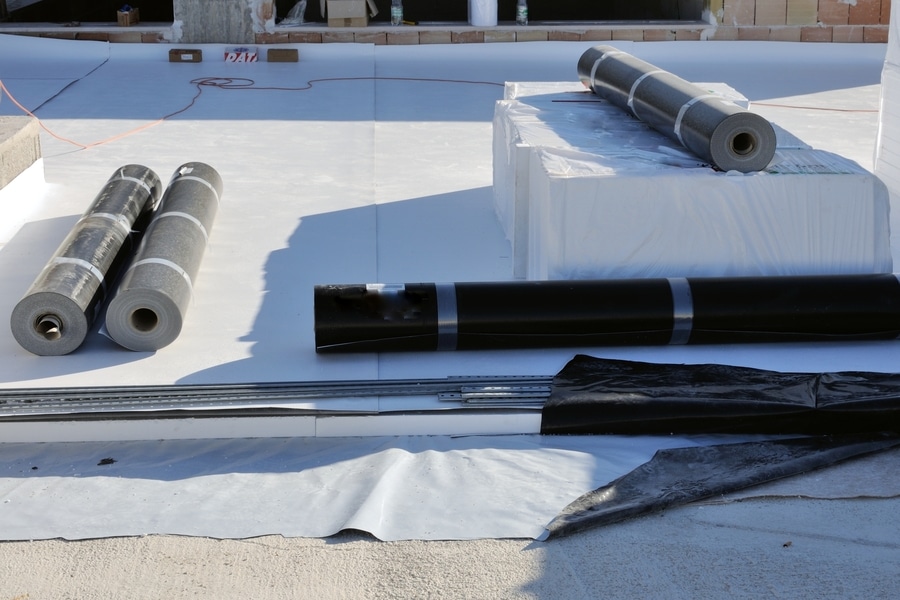500 Hood Road, Suite 320Markham ONL3R 9Z3

Waterproofing is a critical aspect of the building envelope or controlled environment of a building site. From foundations to roofs, walls and floors in between, protection against water is necessary. Often, this added protection is applied during construction, in the form of waterproofing membranes and other techniques.
Although waterproofing a building is often discussed, because it is essentially impossible to keep out 100% of moisture, describing a building as watertight or weatherproof is more usual.
At a certain point in a building's construction, a waterproofing method is used to make it watertight to keep water out. An older building may also undergo renovations and retrofitting to improve its waterproofing system.
Waterproofing extends the life of a building, but many people are not aware of the importance and value of good waterproofing. Water damage affects the structural integrity of a building, and has other negative impacts.
Water causes safety hazards if it leaks into exposed wiring, and could cause fires or electrocution. Pervasive, sitting water, and excessive dampness cause mould, leading to respiratory and other health concerns.
A key concern is that moisture damages materials in the building structure and reduces the lifespan of your building. Waterproofing helps a great deal in keeping water out, consequently providing the maximum service life for your interior spaces and promoting comfort. Simply waterproofing increases the longevity of critical materials like iron, concrete, paint, wood, and others.
Moisture in a building can lead to temperature changes, making the building less comfortable, and making the HVAC systems work more. More energy is used, adding to utility bills. Having a more water-resistant building saves on energy costs over time.
Repairs needed for water-caused damage are expensive, especially if not discovered early. Often, seepage is not detected until it has become a big problem. Fixing the issue, and retrofitting with better waterproofing is costly, and your property will likely have lost value because of the moisture damage.

There are several methods and practices used in construction, working together as a waterproofing system, to make the building as water-resistant as possible.
An initial first step is determining the height of the foundation below grade to determine the waterproofing line. Proper grading is a feature to allow rainwater and other excess water to flow away from the building. When backfilling during construction, a proper grade needs to be maintained.
A drainage system is included to reduce groundwater at the foundation; it must be designed carefully to be fully effective. Often, weeping tiles, or french drains, are used, which have a perforated pipe, with a filter layer to keep dirt, silt, and sand from entering the pipe, which carries water away from the foundation.
The roofing system has waterproofing features, such as sloped roofs and effective gutter systems to allow water to flow away from the building and foundations, as well as other measures. Most commercial buildings have flat, or low slope roofs, and require effective waterproof membranes to be installed to protect the building against the weather.
A waterproof membrane or coating layer is also applied to the foundation. The concrete needs to be cured before applying the membrane so that the moisture it releases as it cures is not trapped inside.
There are a variety of waterproofing products available in the industry, to help keep buildings protected. These membranes are a key part in overall waterproofing systems.
Materials for this are readily available. This form of waterproofing is easy to mix and apply, even in hard to reach internal areas for rooms that are expected to have high moisture, such as a bathroom. However, this method doesn’t go through the contract and expansion process because it is not exposed to weathering and sunlight.
Cementitious waterproofing is somewhat limited, as it is a rigid or only partially flexible form of waterproofing, and should not be exposed to weathering or sunlight, so it is generally only used for interior room applications.
Liquid waterproofing membrane is usually applied in layers by roller or spray and is very flexible, because of its rubbery coating once the liquid cures. Depending on the polymer in the specific product, it can elongate as much as 280%. The polymer will also affect the durability of this liquid coating, but it can last ten years.

Asphalt shingles are common. Three-tab shingles are set in a single, flat layer, with three tabs evenly placed, fitting together evenly once installed for a smooth surface. Architectural asphalt shingles are usually thicker and shaped to look like different roof shingles and have a more layered, three-dimensional appearance.
Asphalt is excellent for low-slope roofing. Built-Up Roofing, Modified Bitumen, and Hybrid Systems are varieties of asphalt roofing.
Polyurethane liquid membrane is another choice, often applied to flat roofs and areas exposed to weathering. It is also very flexible.
When applying a polyurethane liquid membrane, it is critical to assess the concrete it is going to be applied to, for moisture content. Otherwise, the membrane will fail prematurely.
Crystalline waterproofing technology is a newer, eco-friendly solution to the waterproofing problem. There are different products with different chemical compositions, but they can be applied as a slurry layer, integral admixture or dry-shake powder.
When exposed to water, the crystalline waterproofing reacts with byproducts of cement hydration to form microscopic non-soluble crystals that fill the pores cracks in concrete, effectively letting the concrete self-seal. This self-sealing protection lasts for the life of the concrete structure.
There are no Volatile Organic Compounds or petroleum-based products. It doesn't impact air quality. Less material is needed and there is less waste. It doesn't use solvents. It is even certified as safe for use with potable water tanks.
1. Why is waterproofing important in building construction? Waterproofing prevents water damage, enhances structural integrity, and prevents health hazards like mold growth.
2. How does waterproofing save on energy costs? Water-resistant buildings reduce temperature changes and excessive HVAC system use, leading to energy savings.
3. What is the purpose of a drainage system in waterproofing? A drainage system reduces groundwater around the foundation and diverts excess water away from the building.
4. What is the role of roofing systems in waterproofing? Roofing systems, including membranes and effective gutters, prevent water from accumulating on the roof or entering the building.
5. What are common waterproofing materials and their characteristics? Materials include cementitious (interior use), liquid membranes (flexible), bituminous membranes (asphalt-based), polyurethane liquid membranes (flexible), and crystalline waterproofing (self-sealing).
6. How does crystalline waterproofing work? Crystalline waterproofing reacts with cement hydration byproducts to form non-soluble crystals, sealing concrete pores and cracks for the structure's lifespan.
7. What are the benefits of crystalline waterproofing? Crystalline waterproofing is eco-friendly, durable, reduces material waste, and is safe for use with potable water tanks.

Accent Building Sciences is an expert in building envelope engineering. We assess your envelope systems and determine the best waterproofing methods to protect and maintain your building envelope. We also provide insightful guidance on repairs and retrofitting to increase the longevity of your building.

Naji Hassan, a renowned professional in Building Science and Engineering, brings a wealth of knowledge and experience to his field. Educated at Beirut Arab University and Harvard Business School Online, Hassan has honed his expertise in structural and municipal engineering, building science, and business management. As the President of Accent Building Sciences and an experienced Senior Project Manager, he has made significant strides in building envelope engineering, building condition assessments, and energy retrofit programs. His commitment to innovation and excellence is evident in his approach to large-scale project management and his active participation in industry organizations. Hassan is not only a leader in his field but also a prolific writer and thought leader. He regularly shares his insights and experiences through articles on LinkedIn, which can be found at LinkedIn Articles. Additionally, he maintains a blog where he delves deeper into various aspects of building science, accessible at Accent Building Sciences Blog. Outside of his professional pursuits, Hassan enjoys travel, golf, languages, gardening, and music, reflecting his diverse interests and well-rounded character. Naji Hassan's journey in building science and engineering is not just a career but a testament to his lifelong dedication to learning, teaching, and inspiring others in his field.

500 Hood Road, Suite 320Markham ONL3R 9Z3